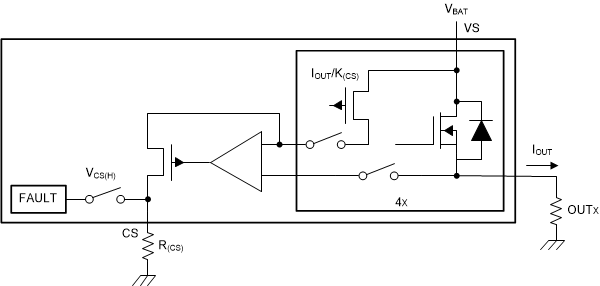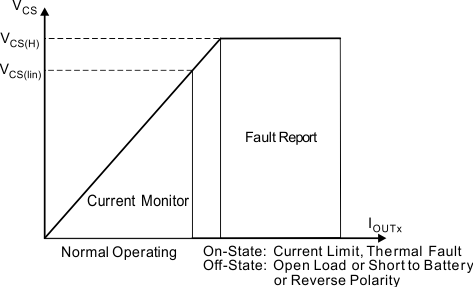JAJSEU4D December 2015 – December 2019 TPS4H160-Q1
PRODUCTION DATA.
- 1 特長
- 2 アプリケーション
- 3 概要
- 4 改訂履歴
- 5 概要(続き)
- 6 Device Comparison Table
- 7 Pin Configuration and Functions
- 8 Specifications
-
9 Detailed Description
- 9.1 Overview
- 9.2 Functional Block Diagram
- 9.3 Feature Description
- 9.4 Device Functional Modes
- 10Application and Implementation
- 11Power Supply Recommendations
- 12Layout
- 13デバイスおよびドキュメントのサポート
- 14メカニカル、パッケージ、および注文情報
パッケージ・オプション
メカニカル・データ(パッケージ|ピン)
- PWP|28
サーマルパッド・メカニカル・データ
- PWP|28
発注情報
9.3.2 Accurate Current Sense
High-accuracy current sense is implemented in the version-B device. It allows a better real-time monitoring effect and more-accurate diagnostics without further calibration.
One integrated current mirror can source 1 / K(CS) of the load current, and the mirrored current flows into the external current sense resistor to become a voltage signal. The current mirror is shared by the four channels. K(CS) is the ratio of the output current and the sense current. It is a constant value across the temperature and supply voltage. Each device is calibrated accurately during production, so post-calibration is not required. See Figure 21 for more details.
 Figure 21. Current-Sense Block Diagram
Figure 21. Current-Sense Block Diagram When a fault occurs, the CS pin also works as a fault report with a pullup voltage, VCS(H). See Figure 22 for more details.
 Figure 22. Current-Sense Output-Voltage Curve
Figure 22. Current-Sense Output-Voltage Curve Use Equation 1 to calculate R(CS).

Take the following points into consideration when calculating R(CS).
- Ensure VCS is within the current-sense linear region (VCS, IOUTx(lin)) across the full range of the load current. Check R(CS) with Equation 2.
- In fault mode, ensure ICS is within the source capacity of the CS pin (ICS(H)). Check R(CS) with Equation 3.

